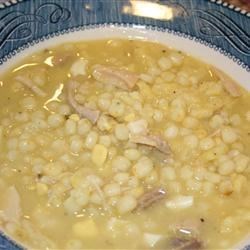 There's a chill in the air signaling the changing of seasons. There's also lots of feathers in the barnyard--the telltale sign of the seasonal moult of laying hens. During this time, egg production decreases significantly as all of the bird's energy goes into growing new feathers.This is also the time hens should be on their best behavior here at the farm. If you're moulting and a constant escapee, you get a one-way ticket to the processor and ultimately, the stew pot.
There's a chill in the air signaling the changing of seasons. There's also lots of feathers in the barnyard--the telltale sign of the seasonal moult of laying hens. During this time, egg production decreases significantly as all of the bird's energy goes into growing new feathers.This is also the time hens should be on their best behavior here at the farm. If you're moulting and a constant escapee, you get a one-way ticket to the processor and ultimately, the stew pot.So it's no surprise this seasonal product--the fatty stewing hen--is starting to show up at farmers market along with their younger, premium brethren--the tender, young broiler.
Don't understand the difference? Think of dairy cows versus beef cattle. One is designed to push their energy into milk production, or in the case of the laying hen, egg production. The other, of course, has been bred to lay down as much meat as possible in the shortest amount of time with the least input (feed).
Just like cattle, there are also "dual-purpose breeds", many that fall into the "heritage" category. However, as producers who rely primarily on animal production for income, many of us have learned that we need to balance market price with affordable production.
Would I like to raise all heritage breeds, which tend to be more colorful and unique? Absolutely! Can I afford a production time twice as long to produce the same amount of meat? No way. The truth is a good farmer worth their salt can feed a utility breed, like the Cornish Giant, a non-GMO feed and raise them outside on pasture making them just as tender, juicy and tasty as their Old World counterparts.
Similarly, as much as I would love to let my old ladies live out their natural lives here in peace on the farm, the reality is that there needs to be a return on my investment and that boils down to eggs or meat.
And just what does one do with a fatty stewing hen?
Here are a number of recipes for you to try as their flavor is unparalleled when it comes to making stock for soup. Fair warning however, their meat is best when shredded, diced or ground.
Schmaltz (aka Jewish Penicillin)
This is rendered chicken fat used in place of butter, lard, tallow, etc. in cooking. Hint: use it to make the crust for Chicken Pot Pie.
Ingredients:
1 fatty stewing hen
Directions:
Remove all fat and skin from carcass. Blot dry with paper towels. Cut into small pieces about the size of a dime using scissors. Place in an uncovered skillet and heat on medium low for 15-20 minutes until liquid fat pools in the bottom of the pan. Remove from heat and strain liquid fat using a mesh strainer into a glass container.
At this point, if you want to make gribenes, the equivalent to cracklins when it comes to pork, add the cooked fat bits back into the pan with a thinly sliced onion and cook until crispy, but not burned.
Chicken Corn Soup
This is a Pennsylvania Dutch staple in late summer.
Ingredients:
1 whole chicken
1 medium onion, chopped
1 cup celery, chopped (note: I like to substitute chard stems)
6 ears fresh corn, kernels cut off cob
4 hard boiled eggs, chopped
8-10 threads saffron
1/2 cup fresh parsley, minced
Salt & Pepper
Directions:
Cover chicken in stock pot with water and bring to a simmer for 2 hours. Remove chicken and pick all meat from bones. Sauté onion, celery and corn until onion is translucent. Add to stock along with picked meat and saffron. Simmer for 20 minutes. Season to taste. Add hard boiled egg and parsley a few minutes prior to serving.
NOTE: Some variations include adding noodles or rivels (pea-sized dumplings made from flour and egg and then dropped into the simmering soup.)
Chicken Pot Pie
Ingredients:
1 whole chicken
1 medium onion, chopped
1/2 cup celery, chopped
2 carrots, sliced
1 cup peas or lima beans
2 tablespoons flour
1/4 cup chicken stock
1 tablespoon minced herbs Salt & Pepper
Crust or Noodles
Directions:
Cover chicken in stock pot with water and bring to a simmer for 2 hours. Remove chicken and pick all meat from bones. Sauté onion, celery, peas and carrot until onion is translucent. Add meat, stock, flour and herbs. Season to taste and simmer until thickened.
To make traditionally Pennsylvania Dutch Pot Pie, add the liquid stock and large flat egg noodles, simmering until noodles are cooked.
For a crusted pie, add chicken and vegetable mixture to crust and top with either another crust or breadcrumbs, cheese and butter. Cook at 350 degrees until bubbly and crust is golden brown.


No comments:
Post a Comment